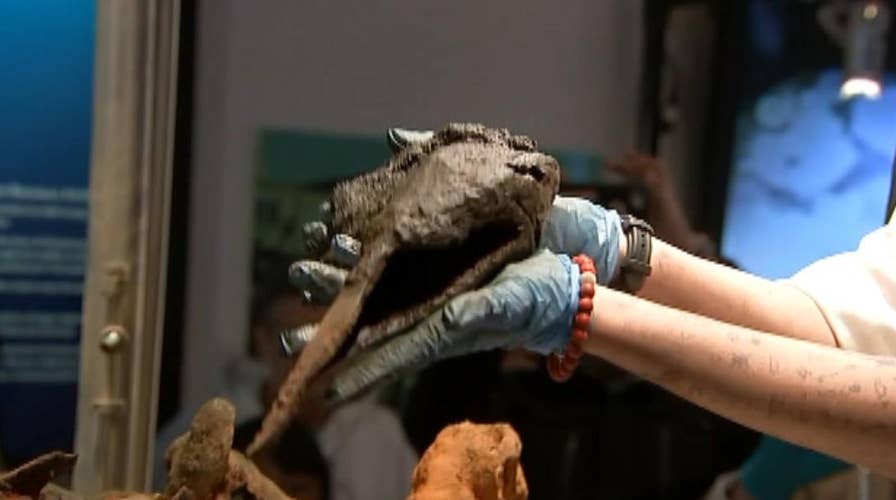Pirate Captain Black Sam Bellamy body found?
The femur of Captain “Black Sam” Bellamy, the world’s richest pirate, may have been found in a large concretion aboard his sunken ship, the Whydah Gally. Researchers are conducting DNA tests to see if it really is the remains of the famed pirate.
Experts are planning to perform DNA analysis on a human bone recovered from a Cape Cod shipwreck to determine whether it belongs to the infamous pirate Samuel "Black Sam" Bellamy.
The Whydah Pirate Museum in Yarmouth, Mass., publicly displayed the bone Monday. The bone, thought be a femur, was found near what's believed to be Bellamy's pistol.
On Monday, the bone was extracted from a 3,600-pound “concretion” – a large chunk of hardened sand and artifacts that was taken from the wreck a number of years ago, the Cape Cod Times reports.
Over 200 concretions have been recovered the wreck site.
INCREDIBLE BLACKBEARD DISCOVERY: STUNNING
FIND ON BUCCANEER'S SHIP REVEALS PIRATE READING HABITS
The 300-year-old bone will now undergo DNA testing to shed new light on the Whydah, which sank in a storm in 1717. The wreck was discovered in 1984.
The museum has enlisted forensic scientists at the University of New Haven to extract DNA and compare it with DNA from a living Bellamy descendant. Testing is expected to take about a month.
“Who is this pirate, who is this lost pirate?” asked Barry Clifford, who discovered the wreck and founded the Whydah Pirate Museum, during a press conference Monday. “Is he Sam Bellamy? Is he African? Is he from Scotland? Ireland? England? Native American? We don’t know yet.”
“This really is an exciting opportunity for us, it’s not every day that we get to work on a case that’s 300 years old,” said Claire Glynn, assistant professor in the University of New Haven’s Forensic Science Department, at the press conference.
WILL CANNONBALL DISCOVERY LEAD TO LOST GALLEON'S SUNKEN 'TREASURE'?
Glynn explained that a Dremel tool will be used to drill into the bone and retrieve a sample.
Typical methods for extracting DNA from bone involve “pulverizing” the bone, according to Glynn. “We have a cryogenic laboratory mill that we will use for this purpose,” she said, but added that a variety of methods might be used.
Scientists will analyze DNA “lineage markers” know as Y-STRs that are passed down through the male line over generations.
Clifford said that there was a lot of ethnic diversity among the Whydah’s crew.
CAPTAIN KIDD’S ‘TREASURE’ FOUND BY DIVERS OFF MADAGASCAR
“There were 180 pirates on the ship – one third of whom were of African origin, most of whom were former slaves,” he explained, adding that many Native Americans were also on the ship.
The Whydah clearly has plenty of secrets still to reveal.
“What the Whydah really represents here in America - it’s America’s version of King Tut’s tomb,” said author and Whydah research team member Casey Sherman, during the press conference.
Since its discovery, some 20,000 coins have been recovered from the wreck, although most of its treasure is thought to remain on the ocean floor. “The treasures that this shipwreck has revealed since 1984, since Barry Clifford discovered the wreck, has been enormous,” said Sherman. “The mother lode of treasure still has yet to be found.”
THIS SHIPWRECK DATES TO WHEN GENGHIS KHAN’S DESCENDANTS RULED CHINA
Experts, however, believe that they may have found the location of the “mother lode” and will be conducting more research at the wreck site off the coast of Wellfleet, Mass., this summer.
"According to primary source documents, there's still a tremendous amount of treasure still on the site," Clifford told Fox News. "We think we know the location where it most likely is."
Bellamy had seized 54 ships in just over two years prior to the Whydah’s sinking, fueling speculation that the wreck is treasure-laden. Forbes has listed the English pirate as the highest-earning pirate ever, plundering about $120 million worth of treasure in a little over a year.
Clifford, who had John F. Kennedy Jr. as his first mate during the 1984 discovery of the wreck, told Fox News that the project has vast amounts of work still to do. "It's going to take more than 6 months just to 'deconcrete' the concretion that we're working on now," he said.
The Associated Press contributed to this article. Follow James Rogers on Twitter @jamesjrogers





















